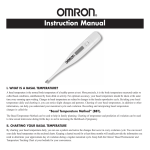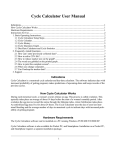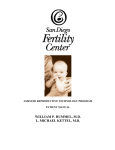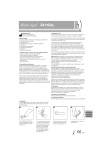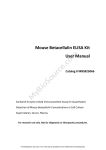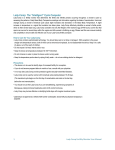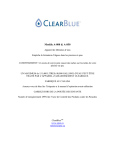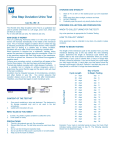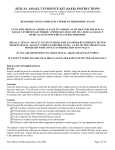Download Natural Family Planning User Manual
Transcript
Marquette University College of Nursing Institute for Natural Family Planning NFP User Manual © 1 Table of Contents: Topic Page Definition of NFP………………………………………………. 3 Philosophy of NFP…………………………………………….. 4 Reproductive Anatomy & Physiology……………………..5-8 How NFP works………………………………………………… 9 Monitoring your hormones……………………………………10 Instructions for avoiding pregnancy (hormones) …….11-12 Charting your fertility (hormones) .………………………13-14 Monitoring your mucus……………………………………..15-18 Instructions for avoiding pregnancy (mucus)…………..18-19 Charting your fertility (mucus)……………………………..20-21 2 MARQUETTE UNIVERSITY NATURAL FAMLIY PLANNING: USER MANUAL The purpose of this user manual is to provide you with information on natural family planning (NFP) so that you can use this information for your family planning intentions. By reading this manual you should be able to: 1. 2. 3. 4. 5. Define natural family planning Understand the philosophical base of NFP Understand human reproductive anatomy and physiology as it applies to NFP Know how NFP works Determine your fertile window by monitoring natural biological markers of fertility (either female hormones or cervical mucus or both) 6. Chart your natural signs of fertility 7. Use this information to either achieve or avoid a pregnancy DEFINITION OF NATURAL FAMILY PLANNING Natural Family Planning (NFP) is a general term that applies to various methods that have been developed to help women and men determine the fertile and infertile times of a woman’s menstrual (monthly) cycle. These methods can be used to achieve or avoid pregnancy. All of the methods rely on the interpretation of natural (biological) signs or indicators of fertility. Implicit in these methods are that couples abstain from intercourse, genital contact or withdrawal during the fertile time of the woman’s cycle if they are avoiding pregnancy. Use of any artificial means to interfere with fertility is not natural family planning. There are four basic methods of natural family planning: • The Calendar Method or (rhythm) - relies on counting cycle length and a simple formula to determine the beginning and end of fertility. • Basal Body Temperature (BBT) - recording of the woman’s daily waking temperature and observing the changing patterns • The Ovulation Method (OM) - observing and recording the patterns and changes of cervical fluids • The Sympto-thermal (ST) Method - combining daily waking temperature, changes in cervical fluid, cycle length and other minor signs of fertility. The term Natural Family Planning, however, usually refers to the two modern methods of natural family planning, i.e., the Ovulation Method (OM) and the Sympto-thermal (ST) method. Modern science and technology also has provided us with the means to accurately monitor other signs of fertility through electronic and chemical fertility devices. The Marquette Model of NFP applies these devices in helping the new learner of NFP to gain confidence in the selfinterpretation of the woman’s natural signs of fertility. All methods of NFP in some way help a man and women to get a better picture of their fertility. Learning about one’s fertility aids in 3 understanding, appreciating and holistically living with this precious gift. PHILOSOPHY OF NATURAL FAMILY PLANNING Sexuality is an integral and good part of human life. When used in an ordered (proper way), sexuality is life giving, integrative and unifying of human relationships. When not used properly (i.e., in a disordered way), sexuality retards human growth, destroys relationships and places an individual at high risk for disease and even death. Sexuality is ordered when expressed in a modest and chaste (non-genital or physical) way when a person is not married and is ordered when expressed chastely and physically between a man and woman who are married to each other. The physical act of intercourse (reserved only for marriage) is proper when it is an expression of love that is open to the possibility of new human life. An act of intercourse between a married man and woman is a true expression of love when there is a total giving of self. Total giving of self includes giving and receiving the gift of fertility. Any act of suppressing, blocking or destroying the gift of fertility or destroying new human life once begun is an act against love and life. Although couples are called to be generous to new life, there are times within married life when spacing or limiting the number of children is prudent and responsible. A married couple discerns this responsibility in a prayerful and selfless way. Serious reasons for spacing or limiting children could be physical (health), psychological (mental health) economic (financial) and social. Serious reasons are determined within the context of valuing the couple’s duties towards God, themselves, their family, and society in a correct ordering of values. When married couples have discerned that there is a need to space or limit children the means to do so must be truthful to love, the integrity of the sexual act and to the gift of fertility. As such, there are times within a woman’s monthly cycle that are fertile and times that are infertile. Natural Family Planning is a means in which a couple learns how to monitor the woman’s monthly cycle and to interpret the natural signs that tell them when the woman is fertile or not. If the couple has serious reasons to avoid pregnancy they then periodically abstain from intercourse and genital contact on the fertile times of the cycle. During this time, couples are challenged to express their intimacy in non-genital ways, i.e., through spiritual (prayer), physical (taking walks together, just holding one another), intellectual (sharing a good book), communicative (talking and listening to each others needs, desires and fears), and emotional (laughing, crying, ) ways. Although this may be difficult and at times seem impossible, God does not ask the impossible and will be with the couple in difficult times in a special way. The practice of NFP and periodic abstinence, far from harming married love actually confers upon married life a higher human value. The many positive benefits of being chaste within marriage and practicing NFP include better understanding of your fertility, increased communication, self-mastery of one’s sexual desires, a greater generosity towards new human life, and an openness to God’s will. HUMAN REPRODUCTION ANATOMY AND PHYSIOLOGY 4 In order to have an appreciation for and an understanding of Natural Family Planning (NFP) it is helpful to have some background in human (male and female) reproductive anatomy and physiology. To begin, you should know that the male cell of reproduction is called the sperm and the female cell of reproduction is called the egg or ovum. The uniting of these two cells is called conception. It is the beginning of human life. The male seeds or sperm are produced in the two male gonads or testes. Besides producing sperm, the testes also produce and secrete the male sex hormone called testosterone. Other male reproductive structures include the ducts and glands that secret fluids which nourish and protect the sperm. The penis introduces millions of sperm into the vagina of the female at the time of intercourse. However, there is only one sperm among millions that will eventually fertilize an egg and result in a new human individual. Sperm can live for 3-5 days when in a good environment. The female eggs or ova are stored in the two acorn sized structures called the ovaries. The ovaries produce the female gametes (ova) and also secrete female sex hormones, estrogen and progesterone. The two ovaries lie within the pelvic cavity (See Figure 1). Other female reproductive structures include the two oviducts (also called fallopian tubes), which carry the sperm to meet the egg and the uterus (or womb) where development of the baby occurs. The uterus is continuous with the vagina, which receives sperm from the male and serves as the lower part of the birth canal. The base and opening of the uterus is called the cervix. The canal that travels from the vagina through the cervix and into the womb is called the endo-cervical canal and this canal is lined with special mucus producing cells. Figure 1: Internal Female Reproductive Anatomy Uterine or Fallopian Tubes Ovary Uterus Cervix Vagina In order for sperm to survive, they need to be in a good environment. The woman’s vagina is acidic and is actually a poor environment for sperm survival. However, at certain times of a woman’s monthly cycle a woman produces a fluid (called cervical mucus) that is optimal for sperm survival. When sperm are in this special woman’s fluid they can live from 3 to 5 days. If no cervical mucus is present in the woman’s vagina, sperm will die within minutes. 5 Men continuously produce sperm throughout their life span. Women on the other hand, have all of the eggs they will ever have at the time of birth. During a women’s monthly menstrual cycle, several eggs will begin to develop and one or more will mature in a tiny structure called the follicle. Ovulation is the time when an egg fully matures in the follicle and is ejected from the ovary. Ovulation occurs on only one day during a woman’s cycle. The mature egg (or eggs) once released, will live approximately one day. Therefore, in order for a woman to become pregnant and for a couple to conceive a baby, three factors need to be present; good sperm from the man, a good egg from the woman; and good cervical mucus for sperm survival. PHASES OF THE MENSTRUAL CYCLE There are three basic phases of a woman’s menstrual cycle: pre-ovulation (the time before ovulation); ovulation (the time the egg is released by the ovary); and post ovulation (the time after the egg dies). Pre-Ovulation The first phase of the woman’s menstrual cycle begins on the first day of her monthly bleeding (menses or period) and ends on the day of ovulation (or, that is, the day the woman releases a mature egg). A woman has thousands of eggs, which are housed in two small sacks called ovaries. There is one ovary on each side of the woman’s body. The ovaries are attached to fallopian tubes, which are long and thin. These tubes are connected to the womb and help to guide the egg to reach the uterus. It is in the fallopian tubes where, if present, sperm will meet egg. In the first part of the menstrual cycle, one or more of the thousands of undeveloped eggs in a woman’s body begin to develop on a signal from a chemical messenger (hormone) follicle stimulating hormone or FSH from the brain (See figure 2). As the egg develops and matures in the follicle, it gives off another important chemical or hormone called estrogen (see figure 2). Estrogen is important for fertility because it helps the inside of the uterus (womb) to develop. It also signals special cells in the opening of the uterus to produce cervical mucus. This mucus is called cervical mucus. Cervical mucus is an important natural indicator of fertility. The length of the pre-ovulation phase of the cycle can change from cycle to cycle in the same woman. For example, a woman could ovulate (release an egg) on day 14 in one cycle and in the next cycle she could ovulate on day 10. Research has revealed that a variety of factors can effect this time of the cycle. Some of those factors include: weight loss; emotional stress (good or bad); illness; too much exercise; and even diet. Despite this variety, the time of fertility can be known by a woman. A woman’s body produces a number of biological signs (or makers) which can help her know when her fertility begins, when she ovulates, and when her fertility ends. Ovulation The second phase of the menstrual cycle is ovulation. Ovulation happens when another body chemical (Luteinizing Hormone or LH) signals the ovary to release a mature egg (See figure 6 2). The releasing of the egg is called ovulation and is the optimal time of fertility. At this time, some women experience breast tenderness and swelling, abdominal pain or cramping, and vulvar swelling. Furthermore, at this time, the cervical opening (OS) widens, softens and fills with sperm friendly (clear-slippery) mucus. Post-Ovulation The next and final phase of the woman’s menstrual cycle begins the first day after ovulation and ends the day before the next period. This time in the woman’s menstrual cycle is called the luteal phase and is relatively stable in length (averaging about 10-16 days in all women). Fig 2: Female Menstrual Cycle and Hormones Hormone Levels – for 28-day cycle: LH FSH Estrogen Progesterone Day 5 10 14 22 28 After ovulation, the body increases the release of another female chemical, a hormone called progesterone (See figure 3). Progesterone has a number of important functions. It elevates the woman’s body temperature about 4-6 tenths of a degree Fahrenheit. This heating up of the woman’s body can be detected by taking daily waking temperatures. Progesterone also prepares the lining of the uterus, for possible implantation of a new human being. Finally, progesterone stimulates cervical cells to produce thick mucus that closes off the opening of the cervix and thus serves as a barrier to sperm and bacteria. If an egg is fertilized by a sperm (i.e., the man’s sperm cell unites with the woman’s egg cell) a new human life will be created. The new person will travel down the fallopian tube in a 6-9 day journey. On about day 10, the baby attaches to the wall of the mother’s uterus. The uterus will then house and feed the new baby for the next 9 months. If the woman’s egg is not fertilized by 7 the man’s sperm, the levels of progesterone will decrease and the lining of the uterus will shed. This shedding of the lining of the uterus is experienced by the woman as bleeding and is called menstruation. Summary of Female Hormones and their functions: Estrogen: Secreted by follicle: • Stimulates cervical mucus production • Stimulates lining of uterus to grow FSH and LH • Stimulates ovulation Progesterone • Heats up female body temperature • Dries cervical mucus • Supports and nourishes lining of uterus Summary Facts on Fertility: There are a number of biological facts that have been discovered in the past century that are necessary to understand how NFP works. They are as follows: • • • • • • A woman only ovulates one day in each cycle An egg lives only 12 to 24 hours Sperm need good mucus to survive Sperm will live 3-5 days in good mucus Sperm will die within hours or minutes when not in good mucus A man and woman together are only fertile for 6 days Factors necessary for pregnancy: 1. Satisfactory ovulation 2. Healthy and open fallopian tubes 3. Healthy endometrium for implantation 4. Healthy cervix with adequate cervical mucus 5. Healthy and adequate sperm 6. Mutual and supportive relationship between the husband and wife is helpful. HOW NATURAL FAMILY PLANNING WORKS A man and woman together are only fertile for six days during a women’s menstrual cycle. These 6 days include the day of ovulation and the 5 days before. The timing of these 6 days of fertility (also called the fertile window) can change from cycle to cycle. The figure below illustrates the variability of the fertile window in three consecutive menstrual cycles. The fertile 8 window is indicated by the blue color days, the red color days indicate the days of menstruation (or the woman’s period), and the green days are the days of infertility. The first cycle in Figure 3 is 29 days in length and the fertile window begins on day 10. The second cycle has 25 days and the fertile window begins on day 6 and the third cycle is 34 days in length and the fertile window begins on day 17. The green infertile days before ovulation are absent in the second cycle since ovulation occurred early. In the third cycle the green days before the fertile phase are longer since ovulation occurred later in this cycle. This illustrates that the day of ovulation and the fertile window can vary from cycle to cycle. It also shows that the post -ovulatory phase is the more stable time of the menstrual cycle and that most of the variability occurs before ovulation. The pos- ovulatory phase in the three cycles below ranges from 12-14 days, while the pre-ovulatory phase ranges from 11-23 days. Fig 3: Variability of the menstrual cycle and the fertile window: 1 2 3 4 5 6 7 8 9 10 11 12 13 14 15 16 17 18 19 20 21 22 23 24 25 26 27 28 29 Fertile Phase Fertile Phase Fertile Phase Natural family planning teaches you how to monitor your fertile phase and the variability of the fertile phase from cycle to cycle. Natural family planning utilizes natural markers of fertility to tell you the beginning, peak and end of the fertile phase. By reading this manual you will learn how to monitor your hormones and cervical mucus to determine your fertile phase. MONITORING YOUR HORMONES The development of new biological and electronic technology now provides women with the ability to self-monitor female hormones. These fertility monitors provide an objective picture of fertility. The most readily available fertility monitoring technologies are the urinary LH test kits - sometimes called ovulation test kits and the Clearblue Fertility Monitor that measures urinary LH and estrogen. Both the Clearblue monitor and the LH test kits are designed to help couple 9 achieve pregnancy. However, when used appropriately and with the proper instructions they can be used as an aid to avoid pregnancy. The Clearblue fertility monitor The Clearblue Fertility Monitor (formally called the ClearPlan Easy Fertility Monitor) is a small hand held battery (4 AAA batteries) operated device (See Figure 4). The monitor has a small window or screen that provides information on the day of the cycle and the level of fertility. It also has a slot where the fertility test sticks are read for the levels of estrogen and LH. The Clearblue test sticks are in white plastic covering. On the end of the test sticks there is a paper strip that contains the assay materials that detect urinary estrogen and LH. Fig. 4. Clearblue fertility monitor The monitor has a small screen on the right hand side (See figure 4). The screen will indicate, the day of the cycle, the level of fertility, and when a test is required. On the right side of the screen is a small button with an “M” on it. The woman user pushes this button on the morning of the first day of her cycle, i.e., the first day of menses or her period. Each morning when waking, she is instructed to push a button on the side of the monitor that will record a new day of the cycle. The Clearblue monitor will then provide the user with information on the day of the cycle. In figure four you can see that it is day 15 of the cycle. At about day 6 of the cycle, the monitor will flash a test strip icon to indicate that a test should be done. The woman user takes a test strip and places it under her urine stream for 3 seconds. The first void in the morning should be utilized. She then places the test strip in the slot on the monitor until it indicates that it has been read. This will take about 30 seconds. The monitor usually will ask for 10 test strips to be read - over a 10-day period. Occasionally, the monitor will require 20 readings. The woman has a 6-hour window in which to perform the test. The 6hour window is triggered when the user pushes the “M” button to indicate the beginning of her cycle. So if the woman user pushes the M button at 6 AM - she will then have from 3 AM to 9 AM to perform the test. Levels of fertility 10 The monitor will provide the user with 3 levels of fertility (Low, High, and Peak Fertility). Low fertility indicates that there is a low probability of achieving a pregnancy on that day. Low fertility is shown by one dark block on the monitor window. High fertility indicates that there is a high probability of achieving pregnancy on that day - the high fertility day is triggered when the monitor picks up a threshold level of urinary estrogen. Two dark blocks on the monitor’s window indicate high fertility. When the monitor window has three dark blocks and the top block has an icon of a ripe follicle that indicates Peak fertility. Peak fertility also means that the LH surge is taking place. The monitor will provide the user with 2 days of Peak fertility. The user will know that after the second day of peak fertility there is a good probability that she will be ovulating the next day. After the 2 days of Peak fertility the monitor automatically will provide one day of High fertility. Advantages and disadvantages The advantages of the Clearblue monitor are that it provides fast accurate, objective, and very clear information about fertility - i.e., low, high and peak fertility. It has two of the best urinary assays to predict ovulation - urinary estrogen and LH. On average the monitor will provide a 2-5 day warning before the actual day of ovulation. It is simple to use and understand. The disadvantage of the monitor, if using to avoid pregnancy, is that the 2-5 day warning period it provides is not long enough to avoid pregnancy and it does not tell anything about the status of cervical mucus. Furthermore the monitor itself costs about $175 and the test strips cost about $18 – 20 dollars per month. INSTRUCTIONS FOR AVOIDING AND ACHIEVING PREGNANCY The Marquette Model of NFP was developed for use of the Clearblue fertility monitor along with a simple algorithm to avoid or achieve a pregnancy. The instruction assumes that the user has purchased a monitor and has read the instructions for proper use and care. The following instructions start on the first day of the users next menstrual cycle. The menstrual cycle begins on the first day of menses or i.e., the first day of the period. There are only 6 days of fertility during a menstrual cycle - the day of ovulation and the 5 days before. The 6 days are called the fertile window. You need to know the beginning, peak and end of the fertile window. The monitor determines the fertile window by measuring urinary metabolites of two female reproductive hormones, estrogen and LH. The monitor will provide you with three levels of fertility – low, high, and peak. The monitor does not always provide an early enough warning of the beginning of the fertile phase and will miss the LH surge (or that is not provide a peak fertility reading) in about 8% of the cycles. Therefore, simple instructions have been developed to go along with the monitor. TO AVOID PREGNANCY: Do not have intercourse, genital contact or practice withdrawal during the fertile window – i.e., from the first day of fertility through the last day of fertility. The length and time of the fertile window will vary from cycle to cycle. Couples who are using the Clearblue fertility monitor as an aid to avoid pregnancy will be asked to avoid intercourse on all “high” and “peak” days and to use the following instructions for determining the fertile window: THE BEGINNING OF FERTILITY: 11 1. Fertility BEGINS on day 6 of the first 6 cycles; After 6 cycles, 2. Fertility BEGINS on the earliest day of “peak” during the last 6 cycles minus 6 days or the first "high" reading on the monitor - whatever comes first. THE END OF FERTILITY: 3. Fertility ENDS 3 full (i.e., 24 hour) days after the last “peak” day on the monitor; After 6 cycles, 4. Fertility ENDS 3 full days after the last “peak” day of the last 6 cycles, or the last "peak" day of the current cycle plus a count of 3 full days - whatever comes first. These instructions are only to be used for those women who have cycles between 22 and 42 days in length and between the ages of 20-42. If there are two or more cycles that fall out of that range or the menstrual cycles vary by more than 10 days, see your professional NFP teacher for advice. After the first 6 cycles the fertile window is re-calculated (based on the previous 6 cycles) for each cycle. Those women who are coming off of hormonal contraception, recently were pregnant, or recently stopped breastfeeding should wait until they have at least 2 natural menstrual cycles in a row before using the monitor and following these instructions. There is a separate protocol being developed for women who are breastfeeding and not in cycles. Women who have polycystic ovaries need to have their cycles regulated before using this protocol. The monitor will not be accurate for women who are on fertility drugs. Tetracycline antibiotics may also affect accuracy of the monitor. ACHIEVING PREGNANCY 1. Have intercourse on the High and Peak days of the monitor. Caution on testing urine You should be aware that the Clearblue monitor misses the LH surge in about 1 out of 10 cycles. When that happens the monitor will continue to ask for test strips for 20 days and you will have 20 days of high fertility readings. That is why there is a formula for the end of the fertile phase (i.e., the latest Peak day of the last 6 cycles plus 3 full days) when that happens. If you experience a missed LH surge (Peak day) more often then 1 out of 10 cycles, then you might be testing your urine the wrong way, e.g., holding the test strip too long under the urine stream. If that happens you might collect the urine in a small container and then dip the test strip in the urine for a timed 15 seconds. CHARTING YOU FERTILITY ON THE FERTILITY CHART The readings from the Clearblue fertility monitor can be placed on the Marquette charting system for easy interpretation and for following the simple instructions for avoiding or achieving pregnancy (See example charts below). The Marquette chart has room for 6 cycles of charting if the cycles are less than 35 days in length. The readings of the Clearblue monitor are recorded as: “L” for low fertility; “ H “ for high 12 fertility; and “P” for peak fertility. The days of the period (menses) are recorded as “3” for heavy bleeding; “2” for moderate bleeding; and “1” for light bleeding. The row of blocks beneath the fertility recordings provides room for recording acts of intercourse as “I”. The couple is advised to place a check (or X) on the line indicated before commencing each cycle as to whether their intention for that cycle is to achieve or avoid pregnancy. The date and day of the cycle should be recorded in the blocks provided above the fertility recordings. For each cycle an arrow should be drawn through the days that the couple understand are the days of fertility. Fig 5: Marquette fertility chart – example of first 6 cycles: The chart in figure 5 shows that fertility begins on day 6 for the first 6 cycles. The earliest Peak day on the monitor for the first 6 cycles was on day 14 in cycle #5. The latest Peak day for the first 6 cycles was on day 17 in cycles #2,3,and 6. Therefore, for the next cycle, fertility will begin on day (14 – 6 ) 8 . Fertility will end on day (17 + 3) 20 or the last Peak day of that cycle plus 3 full days – whatever comes first. You should also notice that this couple indicated they intended to avoid pregnancy for each of the 6 cycles and declared so by placing an “X” in the blanks provided. You can also notice that they only recorded acts of intercourse during the infertile phases of the 6 cycles. During cycle 4 13 there were no “Peak” recordings. That could have happened because the monitor missed the LH surge or because the woman did not ovulate. The monitor asked for 20 test strips and the woman recorded 20 High days. There is no formula for an alternative end of the cycle during the first 6 cycles when that happens. The couple chose to have intercourse on the first low day after the 20 high days! In the next cycle (see figure 6), however, the couple new that day 20 would be the end of the fertile phase if the monitor did not record a Peak. The first 6 cycles only varied by 3 days. Fig. 5: Marquette fertility chart – example of second 6 cycles: MONITORING YOUR CERVICAL MUCUS An important natural sign of fertility that is used in many different methods of NFP are the changes in the characteristics of cervical mucus and the resulting vulvar sensations. Cervical mucus changes its characteristics during the menstrual cycle and can provide the women observer information about the beginning, peak and end of the fertile phase. In the figures below you will find an illustration of the type of mucus you might find during the mucus cycle. The mucus cycle and the fertile window: 14 Menses Cervix closed Dry sensation Cervix begins to open Mucus present Fertility Begins Peak – Cervix open Mucus is at peak Ovulation Occurs Cervix Closed Mucus dries Fertility Ends Fertile Phase – 6 days Cervical mucus changes are a result of the developing egg and follicle in the ovary. When a follicle (with the egg inside) starts to grow early in the menstrual cycle, it begins to produce estrogen. Estrogen stimulates the cervix to produce mucus. Beginning cervical mucus is thick, sticky, and holds its shape. The opening of the cervix at this time also begins to soften and open. As the follicle grows and ripens more estrogen is produced and the cervical mucus changes to a cloudy, thinner and a slightly stretchy type mucus. Fertility is high at this time. Right before ovulation, the follicle is at its largest and produces the most estrogen, cervical mucus at this time is very clear, stretchy, watery, and slippery (like egg white). The cervix is also very soft and the opening widens. Cervical mucus pours out from the cervical opening. The woman is at the peak of her fertility at this time. After ovulation, when the egg is released from the follicle, the follicle changes into a structure called the corpus luteum. The corpus luteum produces the female hormone progesterone. Progesterone heats up the woman’s body about 0.4 to 0.8 degrees, causes the cervical mucus to dry up, and the cervix to close and tighten. The cervical mucus again becomes very thick, cloudy, and forms a plug at the opening of the cervix. When this happens fertility is again at a low level. A woman who observes her mucus on a daily basis, will be able to observe these changes and know that the beginning of her fertility is when mucus first begins to be felt or seen. Her fertility is high when the mucus becomes slightly stretchy and thinner. The peak of her fertility is when the mucus is very clear, stretchy, and slippery. The end of her fertility begins three full days after the last day she observes Peak type mucus. She will only know the Peak day of cervical mucus retrospectively. Beginning fertile mucus Fig. 7: Beginning fertile mucus = Low Fertility 15 Figure 7, shows how cervical mucus might look at the beginning of the mucus cycle or the beginning of the fertile phase. When you observe mucus you can feel for the sensation and observe its characteristics. Many women observe cervical mucus by finger testing, lifting mucus off of a tissue and observing at eye level between the finger and thumb. Early cervical mucus can feel moist or sticky, and appear scant, thick, minimal, white, and hold its shape. When you observe this type of mucus or have no mucus and a dry sensation you are at LOW fertility. Fig. 8: Transitional cervical mucus = High Fertility As the cycle progresses and more estrogen is secreted by the growing follicle, the mucus increases in amount, becomes thinner, cloudy, slightly stretchy. The texture of the mucus might also change from moist and sticky to wet. When you observe mucus with these characteristics you are at HIGH fertility. Fig. 9: Peak fertile mucus = Peak Fertility The Peak of fertility during the menstrual cycle is when peak type mucus is present. Mucus at this time has a very slippery (lubricative) sensation. It appears transparent, clear, is very stretchy and looks similar to raw egg white. At the peak of fertility, cervical mucus is very profuse and literally pours out of the cervix over a 24-hour period. Sometimes the mucus is so watery that there is no mucus to pick up and the women will only notice a very wet, slippery sensation. The PEAK DAY of cervical mucus: The last day of any mucus that is clear (transparent), stretchy, and/or has the sensation of slippery is considered the peak of cervical mucus and the Peak Day. After the Peak day there is an obvious change to sticky, tacky, cloudy type mucus or to dry (i.e., no mucus appears at the vulva and there is a dry sensation). Therefore, the Peak Day will only be known retrospectively! Fertility is High for 3 full days after the Peak day of cervical mucus! The Mucus Cycle 16 Fertility Level: Low High Peak High This figure shows a typical mucus cycle going from minimal, progressing to stretchy cloudy, then to peak and back again to tacky cloudy type mucus. Mucus cycles will vary from women to women and from cycle to cycle! Observing your cervical mucus There are a number of ways to observe cervical mucus. In order to determine the sensation produced by the cervical mucus during the cycle, the woman observer needs to make mental checks of what sensations she feels at the vulva (i.e., the lips of the vagina). Mental checks should be made throughout the day, when going to the bathroom and before going to bed. It is also recommended that the women observe the mucus. Many women do this by using soft white (non-scented) toilet tissue and wiping or blotting the vulva. The mucus can be observed on the tissue for its color and appearance. Finger testing then can be used to determine the consistency of the mucus. To do this, the woman lifts the mucus off of the tissue and observes it at eye level between the finger and thumb. When finger testing the mucus she can also determine how stretchy and transparent the mucus is. Another determinate for the consistency is how far it will stretch before snapping, referred to as the “stretch to snap”, the spinnbarkeit or Spinn effect. It is important to be consistent with making the observations on a daily basis and recording what you see on a fertility chart. If you miss or skip observations you will not have a complete record of your fertility. At the end of the day, after the last check before going to bed, the most fertile observation should be recorded on a fertility chart. Tips on Observing Your Cervical Fluid and Vulval Sensations 1. Begin observing for and sensing the cervical fluid as soon as your bleeding (i.e., period) becomes light or spotty or no later than the first day after menstruation has ended. 2. Focus on the sensation that is felt at the vulva (vaginal lips) during the day and make a mental note while wiping with the tissue. The sensation of lubrication or slipperiness should be an obvious sensation. 3. If you wish, collect a sample of the cervical fluid (mucus) with toilet tissue and observe the mucus between your finger and thumb. 4. If you have difficulty differentiating between cervical fluid and vaginal secretions, dip the sample in a glass of water. If the sample is cervical fluid it will form a blob and sink. If it is vaginal secretions it will dissolve. Slippery cervical fluid should feel slippery even when held under water - like a FISH. INSTRUCTIONS FOR ACIEVING OR AVOIDING PREGNANCY (CERVICAL MUCUS) 17 Avoiding Pregnancy The basic instructions for avoiding pregnancy are quite simple (and intuitive). Essentially, if you want to avoid pregnancy DO NOT HAVE INTERCOURSE OR GENITAL CONTACT DURING THE FERTILE PHASE. The corollary to this is that you can have intercourse or genital contact during the two infertile phases. However, in the pre-ovulatory infertile phase (also called the relative infertile phase) you should limit intercourse and genital contact to the end of the day only. The reason that it is limited to end of the day only is because the daily activity of the woman observer is what helps to bring down cervical mucus to the opening of the vagina. Thus, it is at the end of the day that the woman/couple user can be sure of her cervical mucus indicator. Another reason is that the pre-ovulatory phase of the cycle is the phase that varies the most. Using greater caution in this phase is common sense. The following algorithm for determining the fertile phase with the cervical mucus sign is for women who have cycles between 22 and 42 days in length. Those who have cycles longer or shorter than that range or who have cycle lengths that vary more than 8 days should consult with a professional NFP teacher. BEGINNING OF FERTILITY: 1. For the first 6 cycles fertility begins on day 6; After 6 cycles; 2. Fertility begins on the earliest Peak mucus day minus 6 days or the first day of High mucus that felt or seen (whatever comes first). END OF FERTILITY: 1. Fertility ends on the evening of the 4th day past the Peak in cervical mucus. ACHIEVING PREGNANCY: 1. To achieve pregnancy have intercourse on the days of High and Peak cervical mucus! Additional Instructions: (Cervical Mucus and Special Fluids) (AROUSAL FLUID AND SEMINAL FLUID) There are other fluids, both from the man and woman, you need to know about when you are using NFP to either avoid or achieve pregnancy. The special fluid produced by the woman is called arousal fluid and the fluid from the man is called seminal fluid. Both of these fluids can cause confusion when monitoring and charting your signs of fertility, in particular the observations you make of your cervical mucus and vulval sensations. Arousal Fluid: Arousal fluid is a fluid that is produced in response to either physical or mental 18 sexual stimulation. Some mothers who breast-feed their infants might also experience this fluid while breast-feeding. The fluid is produced by two glands, called Bartholin Glands, that are situated near the opening of the vagina. The physiological purpose of the fluid is to lubricate the vagina for the possibility of intercourse. The characteristics of arousal fluid are clear, wet, moist, and slippery. Unlike cervical fluid, however, arousal fluid dissipates quickly (i.e., within one hour). The guidelines for arousal fluid with the use of NFP are as follows: • If you are sure that it is arousal fluid - wait for it to dissipate (i.e., to go away in about an hour) and ignore it! • If you are unsure, observe and chart it on its merits. Seminal Fluid: Seminal fluid is the fluid released from the man at the time of intercourse. Seminal fluid of course contains sperm and other fluids that nourish, protect and prepare them (the sperm) for possible fertilization of the ovum. After intercourse it is a common practice (and recommended for hygienic purposes) that a woman get up and void (urinate). However, she should not get up immediately after intercourse. The time after intercourse obviously is a special intimate time that is important for bonding. After about 20-30 minutes after intercourse, the seminal fluid becomes very fluid. At this time it is recommended that a woman rid herself of the seminal fluid that has remained in her vagina. To do this she should (after urinating) in alternating fashion 1) bear down (like she is having a bowel movement) and 2) do five or six Kegel’s exercises (i.e., tightening the muscles of the vagina and the muscles that stop or start urination). After she does 4-5 sets of bearing down and Kegels exercises she should wipe until all the seminal fluid is gone. The next day, whatever, mucus or sensations are observed should be charted on their merits. Not all women may wish to get up after intercourse and choose to remain bonded with her husband or just fall asleep. If this is so, then if she is confident what she observes the next day is seminal fluid then she can ignore it. She also might just ignore her observations until after 12noon. By that time most of the seminal fluid should have left the vagina. CHARTING YOUR FERTILITY ON THE CERVICAL MUCUS CHART: You cervical mucus observations can be placed on the Marquette charting system for easy interpretation and for following the simple instructions for avoiding or achieving pregnancy (See example charts below). The Marquette chart has room for 6 cycles of charting if the cycles are less than 35 days in length. The cervical mucus readings are recorded as: “L” for mucus that is scant, thick and cloudy – the “L” signifies LOW fertility; “ H “ for mucus that stretches slightly, is thinner and cloudy, the “H” stands for HIGH fertility; and “P” is recorded for mucus that is clear, stretchy and slippery (egg white type) – the “P” stands for peak fertility. The days of the period (menses) are recorded as “3” for heavy bleeding; “2” for moderate bleeding; and “1” for light bleeding. The row of blocks beneath the fertility recordings provides room for recording acts of intercourse as “I”. The couple is advised to place a check (or X) on the line indicated before commencing each cycle as to whether their intention for that cycle is to achieve or avoid pregnancy. The date 19 and day of the cycle should be recorded in the blocks provided above the fertility recordings. For each cycle an arrow should be drawn through the days that the couple understand are the days of fertility. Fig 10: Example Mucus cycle chart of first 6 cycles 20 The chart in figure 10 shows that fertility begins on day 6 for the first 6 cycles. The earliest Peak day observed by the example was on day of the last 6 cycles was on day 14 in cycle #1. Therefore, for the next cycle, fertility will begin on day (14 – 6 ) 8 or the first day of a High mucus recording – whatever comes first. Fertility will end on the last Peak day of that cycle plus 3 full days. You should also notice that this couple indicated that intended to avoid pregnancy for each of the 6 cycles and declared so by placing an “X” in the blanks provided. You can also notice that they only recorded acts of intercourse during the infertile phases of the 6 cycles. In figure 11 below is an example of the next 6 cycles that the woman experienced and charted. You can notice that in the 4th cycle she re-calibrated the beginning of the fertile phase due to the fact that the earliest peak day cycle in cycle number 3 was on day 13, therefore, for the next cycle fertility began on day 7. In cycle 13, the mucus observation was the first indicator of fertility, not the algorithm. Fig. 11: Marquette mucus fertility chart – example of second 6 cycles: 21





















